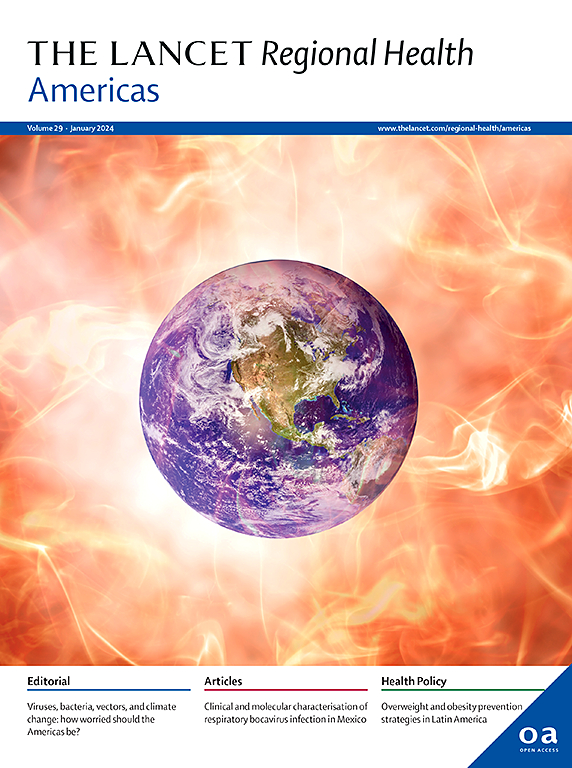Spatiotemporal patterns and surveillance artifacts in maternal mortality in the United States: a population-based study
IF 7
Q1 HEALTH CARE SCIENCES & SERVICES
引用次数: 0
Abstract
Background
Reports of high and rising maternal mortality ratios (MMR) in the United States have caused serious concern. We examined spatiotemporal patterns in cause-specific MMRs, in order to obtain insights into the cause for the increase.
Methods
The study included all maternal deaths recorded by the Centers for Disease Control and Prevention from 1999 to 2021. Changes in overall and cause-specific MMRs were quantified nationally; in low-vs high-MMR states (i.e., MMRs <20 vs ≥26 per 100,000 live births in 2018–2021); and in California vs Texas (populous states with low vs high MMRs). Cause-specific MMRs included those due to unambiguous causes (e.g., selected obstetric causes such as pre-eclampsia/eclampsia) and less-specific/potentially incidental causes (e.g., “other specified pregnancy-related conditions”, chronic hypertension, and malignant neoplasms).
Findings
MMRs increased from 9.60 (n = 1543) in 1999–2002 to 23.5 (n = 3478) per 100,000 live births in 2018–2021. The temporal increase in MMRs was smaller in low-MMR states (from 7.82 to 14.1 per 100,000 live births) compared with high-MMR states (from 11.1 to 31.4 per 100,000 live births). MMRs due to selected obstetric causes decreased to a similar extent in low-vs high-MMR states, whereas the increase in MMRs from less-specific/potentially incidental causes was smaller in low- vs high-MMR states (MMR ratio (RR) 5.57, 95% CI 4.28, 7.25 vs 7.07, 95% CI 5.91, 8.46), and in California vs Texas (RR 1.67, 95% CI 1.03, 2.69 vs 10.8, 95% CI 6.55, 17.7). The change in malignant neoplasm-associated MMRs was smaller in California vs Texas (RR 1.21, 95% CI 0.08, 19.3 vs 91.2, 95% CI 89.2, 94.8). MMRs from less-specific/potentially incidental causes increased in all race/ethnicity groups.
Interpretation
Spatiotemporal patterns of cause-specific MMRs, including similar reductions in unambiguous obstetric causes of death and variable increases in less-specific/potentially incidental causes, suggest misclassified maternal deaths and overestimated maternal mortality in some US states.
Funding
This work received no funding.
美国孕产妇死亡率的时空模式和监测误差:一项基于人口的研究
背景据报道,美国孕产妇死亡率(MMR)居高不下且不断上升,引起了人们的严重关注。我们研究了特定病因的孕产妇死亡率的时空模式,以深入了解孕产妇死亡率上升的原因。方法该研究包括美国疾病控制和预防中心从 1999 年到 2021 年记录的所有孕产妇死亡案例。对全国、低MMR州与高MMR州(即2018-2021年每10万活产的MMR<20 vs ≥26)以及加利福尼亚州与德克萨斯州(低MMR州与高MMR州)的总体和特定原因MMR的变化进行了量化。病因特异性MMR包括由明确病因(如选定的产科病因,如先兆子痫/子痫)和不太特异性/可能偶然的病因(如 "其他特定的妊娠相关疾病"、慢性高血压和恶性肿瘤)引起的MMR.研究结果MMR从1999-2002年的每10万活产9.60例(n=1543)增加到2018-2021年的23.5例(n=3478)。与高MMR州(从每10万活产11.1例增至31.4例)相比,低MMR州(从每10万活产7.82例增至14.1例)MMR的时间增幅较小。在低MMR州与高MMR州中,选定的产科原因导致的MMR下降幅度相似,而在低MMR州与高MMR州中,非特异性/潜在偶然原因导致的MMR增加幅度较小(MMR比值(RR)为5.57,95% CI为4.28,7.25 vs 7.07,95% CI为5.91,8.46),在加利福尼亚州与得克萨斯州中也是如此(RR为1.67,95% CI为1.03,2.69 vs 10.8,95% CI为6.55,17.7)。加利福尼亚州与得克萨斯州相比,恶性肿瘤相关 MMR 的变化较小(RR 1.21,95% CI 0.08,19.3 vs 91.2,95% CI 89.2,94.8)。在所有种族/民族群体中,非特异性/潜在偶发原因导致的孕产妇死亡率均有所上升。释义特异性原因导致的孕产妇死亡率的时空模式,包括非明确产科死因的类似减少和非特异性/潜在偶发原因的不同增加,表明美国一些州对孕产妇死亡进行了错误分类,并高估了孕产妇死亡率。
本文章由计算机程序翻译,如有差异,请以英文原文为准。
求助全文
约1分钟内获得全文
求助全文
来源期刊

Lancet Regional Health-Americas
Multiple-
CiteScore
8.00
自引率
0.00%
发文量
0
期刊介绍:
The Lancet Regional Health – Americas, an open-access journal, contributes to The Lancet's global initiative by focusing on health-care quality and access in the Americas. It aims to advance clinical practice and health policy in the region, promoting better health outcomes. The journal publishes high-quality original research advocating change or shedding light on clinical practice and health policy. It welcomes submissions on various regional health topics, including infectious diseases, non-communicable diseases, child and adolescent health, maternal and reproductive health, emergency care, health policy, and health equity.
 求助内容:
求助内容: 应助结果提醒方式:
应助结果提醒方式:


